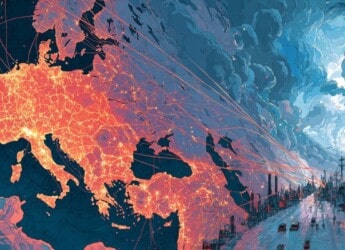|
|
Content Assessment: Five Hundred Days: Russo-Ukrainian War Update (July 2-8, 2023)
Information - 93%
Insight - 94%
Relevance - 92%
Objectivity - 94%
Authority - 95%
94%
Excellent
A short percentage-based assessment of the qualitative benefit of the post highlighting the recent Ukraine conflict assessments in maps from the Institute for the Study of War.
Editor’s Note: The discipline of eDiscovery, which involves the identification, preservation, and analysis of electronic data, is increasingly being used in investigations and litigation relating to war crimes. In the case of the Russo-Ukrainian War, eDiscovery tools and techniques can be used to identify and collect electronic evidence of war crimes, such as emails, social media posts, and other digital communications that may provide valuable insights into the actions of individuals and organizations involved in the conflict. This evidence can then be used in investigations and legal proceedings to hold perpetrators of war crimes accountable for their actions. Additionally, eDiscovery can help to efficiently and effectively manage the vast amount of electronic evidence that may be relevant to war crimes cases, allowing investigators and legal teams to quickly and accurately analyze the data to identify key pieces of information. This weekly update may be useful for cybersecurity, information governance, and legal discovery professionals as they consider investigations and litigation resulting from war crimes committed during the war.
Background Note: According to the Institute for the Study of War (ISW), it’s now been 500 tension-filled days since Russia unsheathed the sword of war on Ukraine, in a move that came out of the blue. In their high-stakes gamble, the Russian military had Kyiv in their crosshairs, hoping to annex the capital within a mere 72 hours. But that was a target they’ve spectacularly missed.
Ukrainian forces, demonstrating unyielding resolve and deft military strategy, have proved to be a formidable adversary. Their determination has been crucial in quelling wave after wave of Russian incursions, including the one directed squarely at the heart of Kyiv. The tides of war have turned, with Ukrainian forces reclaiming not only Sumy and Chernihiv, but also parts of Kharkiv, Mykolaiv, and Kherson – regions briefly cloaked under the Russian banner.
Today, it’s the Ukrainians who hold the strategic upper hand, masterminding counteroffensive maneuvers along most of the war-torn frontline. Russian forces, once the aggressors, now find themselves in a defensive posture, battling to retain the Ukrainian territories that they still hold.
With Western allies in their corner, Ukraine has managed to hold onto its cherished independence. But the war is far from over. The formidable challenge that lies ahead for these brave Ukrainians is to liberate the remaining critical regions still gripped by Russian control. The fight continues.
Source Note: One of the most accurate and detailed sources for ongoing updates on the Ukraine crisis is the Russian Offensive Campaign Assessment from the Institute for the Study of War. The Institute for the Study of War (ISW) is a 501(c)(3) organization and produces strictly non-partisan, non-ideological, fact-based research. ISW seeks to promote an informed understanding of war and military affairs through comprehensive, independent, and accessible open-source research and analysis. ISW’s research is made available to the general public, military practitioners, policymakers, and media members. Providing a daily synthesis of key events related to the Russian aggression against Ukraine, ISW updates may benefit investigators and litigators as they follow the business, information technology, and legal trends and trajectories impacted by and stemming from the current Russo-Ukrainian conflict.
Assessment and Maps*
Russo-Ukrainian Conflict Assessments – An Overview in Maps
- Institute for the Study of War (ISW), Russia Team
- Critical Threats Project (CTP), American Enterprise Institute
General Assessment Background Info
- ISW systematically publishes Russian campaign assessments that include maps highlighting the assessed control of terrain in Ukraine and main Russian maneuver axes.
- These maps augment daily synthetic products that cover key events related to renewed Russian aggression against Ukraine.
The Russian Offensive Campaign Assessments
- July 8, 2023
- By Karolina Hird, Kateryna Stepanenko, Grace Mappes, Nicole Wolkov, George Barros, Angelica Evans, and Frederick W. Kagan
Key Takeaways
- Five hundred days ago Russia launched an unprovoked war of conquest against Ukraine.
- Ukrainian forces conducted counteroffensive operations on at least three sectors of the front on July 8. US Under Secretary of Defense for Policy Colin Kahl noted on July 7 that current Ukrainian operations across the front are the “beginning of the middle” of the wider counteroffensive and that it is therefore “too early to judge” how the counteroffensive is going.
- The United States announced a new military aid package for Ukraine that includes cluster munitions on July 7.
- Russian forces conducted another series of Shahed 131/136 drone and missile strikes against Ukraine’s industrial and infrastructure facilities overnight from July 7 to 8.
- Turkish President Recep Tayyip Erdogan stated that Ukraine “deserves NATO membership” ahead of the July 11 to 12 NATO summit in a press conference on July 7 in Istanbul with Ukrainian President Volodymyr Zelensky. Zelensky returned to Ukraine from Turkey with five Ukrainian commanders involved in the defense of Azovstal Metallurgical Combine in Mariupol, Donetsk Oblast whom Ukraine, Russia, and Turkey had previously agreed would remain in Turkey until the end of the war.
- Ukrainian intelligence indicated that Russian authorities are capitalizing on the fear of a provocation at the Zaporizhzhia Nuclear Power Plant (ZNPP) to drive out Ukrainian personnel and increase the Russian presence at the ZNPP ahead of the upcoming NATO summit.
- A Wagner commander stated that the Wagner Group will go to Belarus after completing rest and recuperation through August 2023. The status of the deal between Russian President Vladimir Putin and Prigozhin is unclear, and the deal may be in flux.
- The Kremlin may be attempting to ensure that it has control over Wagner leadership and personnel in Africa and the Middle East.
- A prominent Russian milblogger speculated that the Russian military leadership may be in the process of making the decision to replace Defense Minister Sergei Shoigu, suggesting that the implications of the June 24 Wagner Group rebellion may still be having ramifications on the highest echelons of military command.
- Russian authorities reportedly prevented former Russian officer and ardent nationalist Igor Girkin from holding a talk about the Wagner Group rebellion.
- Russian forces conducted ground attacks along the Kharkiv-Luhansk Oblast border and south of Kreminna, and Ukraine likely continues to conduct strikes on Russian concentration areas deep within the rear of occupied Luhansk Oblast.
- Ukrainian and Russian forces conducted ground attacks around Bakhmut.
- Russian forces conducted limited ground attacks along the Avdiivka-Donetsk City line.
- Russian and Ukrainian forces continued ground attacks along the administrative border between Zaporizhia and Donetsk oblasts on July 8.
- Ukrainian forces continued counteroffensive operations in western Zaporizhia Oblast.
- Russian Defense Minister Sergei Shoigu reportedly observed combat training of Russian contract servicemen at the Southern Military District (SMD) training grounds on July 8, likely in an attempt to favorably portray Russian formalization efforts and incentivize personnel recruitment.
- The Ukrainian government has indicated that Russian occupation authorities struggle to compensate staff in critical industries, resulting in staffing shortages that could hinder the Russian war effort.
- July 7, 2023
- By Riley Bailey, Grace Mappes, George Barros, Nicole Wolkov, Karolina Hird, Angelica Evans, and Frederick W. Kagan
Key Takeaways
- Ukrainian forces made tactically significant gains in the Bakhmut area and continued counteroffensive operations in at least three other sectors of the front on July 7.
- Russian forces have reportedly committed almost the entirety of the Russian Eastern Grouping of Forces to southern Ukraine.
- The deployment of almost the entirety of the Russian Eastern Grouping of Forces and extensive SMD elements to the frontline in southern Ukraine suggests that Russian defenses in southern Ukraine may be brittle.
- Russia temporarily disconnected at least partially from the global internet during a test of its “sovereign internet” system overnight on July 4-5.
- Russian forces conducted a series of missile and drone strikes against rear areas in Ukraine on June 6 to 7.
- Russian and Ukrainian forces continued ground attacks along the Kharkiv-Luhansk Oblast border. Ukrainian forces made tactically significant gains in the Bakhmut area between July 6-7.
- Russian and Ukrainian forces conducted ground attacks in western Donetsk Oblast.
- Russian sources claimed that Ukrainian forces launched a renewed wave of counterattacks in western Zaporizhia Oblast on July 7.
- The Russian occupation of the Zaporizhzhia Nuclear Power Plant (ZNPP) continues to restrict international monitors’ access to the facility.
- The Russian Ministry of Defense (MoD) reportedly drafted a law that would expand the list of gross disciplinary offenses within the Russian Armed Forces.
- Russian authorities continue to portray themselves as responsible custodians of Ukrainian children in an effort to discredit Ukraine while continuing to forcibly deport Ukrainian children to Russia.
- A Belarusian military official stated that Wagner Group forces have not yet decided to deploy to Belarus while giving a press tour of the speculated Wagner Group base in Asipovichy on July 7.
- July 6, 2023
- By Kateryna Stepanenko, Riley Bailey, Karolina Hird, Angelica Evans, and Frederick W. Kagan
Key Takeaways
- Belarusian President Alexander Lukashenko stated that Wagner Group financier Yevgeny Prigozhin and Wagner forces are not in Belarus as of July 6, indicating that Prigozhin may be failing to uphold the deal Lukashenko mediated between Prigozhin and Russian President Vladimir Putin following Wagner’s armed rebellion on June 24.
- Russian sources also indicated that Prigozhin is in Russia, although ISW cannot confirm Prigozhin’s whereabouts at this time.
- Lukashenko appears to be distancing himself from the deal he reportedly mediated while continuing to tout his ability to mediate between Putin and a formerly loyal lieutenant in the first place, thus still highlighting Putin’s weakness.
- Prigozhin’s ability to freely operate in Russia suggests that Prigozhin is still protected by some security guarantees and/or that the Kremlin continues to prioritize undermining his reputation in Russia over targeting Prigozhin physically or legally.
- Select Russian ultranationalists criticized Russian state propaganda for attempting to villainize Prigozhin, however, suggesting that the Kremlin’s attempt to alienate the ultranationalist community from Prigozhin is not succeeding.
- Ukrainian forces conducted counteroffensive operations on at least three sectors of the front on July 6 and are continuing efforts to gradually degrade Russian manpower and logistics assets.
- Ukrainian and Russian officials largely de-escalated their rhetoric regarding the Zaporizhzhia Nuclear Power Plant (ZNPP) on July 6.
- Russian political actors continue attempts to court or control Russian milbloggers, indicating that many view the milblogger community as a critical constituency.
- Russian opposition media outlet Vertska reported that Russian forces and occupation authorities are conducting a campaign of systematic religious persecution in occupied Ukraine.
- Russian milbloggers claimed that aspects of Russian defensive operations in southern Ukraine have severe limitations and may not be as effective as Russian sources have previously portrayed them.
- Russian and Ukrainian forces conducted ground attacks along the Svatove-Kreminna line.
- Visual evidence confirms that Ukrainian forces have advanced southwest of Bakhmut as of July 6.
- Russian forces continued ground attacks in the Bakhmut and Avdiivka-Donetsk City areas.
- Ukrainian forces conducted counteroffensive operations along the administrative border between Zaporizhia and Donetsk oblasts and in western Zaporizhia Oblast.
- Russian officials continue efforts to create territorial defense units in Russian border oblasts.
- Occupation officials continue efforts to forcibly assimilate Ukrainian legal and cultural traditions into the Russian system in occupied territories.
- Belarusian President Alexander Lukashenko claimed on July 6 that Russia will transfer all planned tactical nuclear weapons to Belarus by the end of 2023, if not earlier.
- July 5, 2023
- By Riley Bailey, Kateryna Stepanenko, Grace Mappes, Angelica Evans, George Barros, and Frederick W. Kagan
Key Takeaways
- Ukrainian forces reportedly conducted counteroffensive operations in five sectors of the front on July 5 and made gains in some areas.
- Ukrainian forces reportedly conducted a series of missile strikes targeting Russian rear positions along the entire front overnight and during the day on July 5.
- Ukrainian and Russian officials maintained their heightened rhetoric regarding the situation at the Zaporizhzhia Nuclear Power Plant (ZNPP) on July 5 following significant claims of a possible attack against the plant overnight on July 4-5. Russia likely continues setting informational conditions for a possible false flag attack against the ZNPP, but remains unlikely to cause a radiological incident at this time.
- Ukrainian officials reported that Russia continues to procure Iranian-made Shahed drones and is setting conditions to manufacture these drones in Russia with Iran’s assistance.
- The Kremlin continues to show concern over the risk of a potential armed rebellion in Russia after Wagner Group’s rebellion on June 24.
- The Financial Times (FT) reported that Chinese President Xi Jinping personally warned Russian President Vladimir Putin against threatening to use nuclear weapons in Ukraine during his visit to Moscow in late March.
- Russian Prime Minister Mikhail Mishustin dismissed Sergei Mikhailov from his position as General Director of TASS state newswire and replaced him with Andrey Kondrashov.
- Russian forces continued offensive operations along the Kupyansk-Svatove line, and Russian and Ukrainian forces continued skirmishing around Kreminna.
- Ukrainian forces conducted successful offensive operations in the Bakhmut area, and Russian milbloggers reported that Ukrainian forces liberated an important height near Klishchiivka (7km southwest of Bakhmut).
- Russian and Ukrainian forces continued ground attacks along the Avdiivka-Donetsk City line.
- Ukrainian forces continued ground attacks in the western Donetsk Oblast-eastern Zaporizhia Oblast border area and in western Zaporizhia Oblast.
- A Ukrainian official confirmed that Ukrainian forces maintain positions in east (left) bank Kherson Oblast.
- Ukrainian officials reported that Russia’s hybrid cryptomobilization and contract service recruitment campaigns have failed to produce large numbers of recruits, contrary to Russian claims.
- Russian officials are setting information conditions to postpone regional elections in occupied Ukraine likely out of concerns for successful Ukrainian counteroffensives.
- July 4, 2023
- By Karolina Hird, Grace Mappes, Nicole Wolkov, Angelica Evans, and Frederick W. Kagan
Key Takeaways
- Ukrainian forces appear to be focusing on creating an asymmetrical attrition gradient that conserves Ukrainian manpower at the cost of a slower rate of territorial gains, while gradually wearing down Russian manpower and equipment. The current pace of Ukrainian operations is not indicative of a stalemate or evidence that Ukraine cannot retake large areas.
- Ukrainian forces continued counteroffensive operations on at least four sectors of the front and advanced on July 4.
- Russian and Ukrainian officials escalated their rhetoric surrounding the situation at the Zaporizhzhia Nuclear Power Plant (ZNPP) on July 5, but Russia is likely focused on accusing Ukraine of irresponsible actions around the ZNPP including setting conditions for a possible false flag attack. Russia remains unlikely to generate a radiological incident at the ZNPP at this time.
- The reported reorganization of Russian internal security organs suggests that the Kremlin has not yet concluded that it has effectively neutralized the threats of future armed rebellions following the Wagner Group’s June 23-24 rebellion.
- Russian authorities are absolving Wagner Group financier Yevgeny Prigozhin of financial responsibility for damages caused by the Wagner Group rebellion and reportedly returned significant liquid assets to Prigozhin, possibly as part of the deal negotiated between Putin, Prigozhin, and Belarusian dictator Alexander Lukashenko.
- The official Chechen response to an attack against a Russian opposition journalist in Chechnya may impact Chechen Republic Head Ramzan Kadyrov’s standing in the Russian ultranationalist information space.
- Kadyrov’s prominence in the broader Russian information space will likely force Kadyrov to choose between preserving his regime and his support in the ultranationalist information space, however.
- Russia is reportedly forming a new combined arms army as part of the Northern Fleet, likely in order to posture its preparedness against NATO.
- The Russian Ministry of Defense (MoD) claimed that Ukrainian forces conducted a drone attack on Moscow Oblast and Novaya Moskva on July 4.
- Russian conducted limited ground attacks along the Kupyansk-Svatove-Kreminna line and south of Kreminna.
- Russian sources claimed that Ukrainian forces conducted limited ground attacks along the Kupyansk-Svatove-Kreminna line.
- Russian and Ukrainian forces escalated ground attacks in the Bakhmut area.
- Russian forces continued ground attacks along the Avdiivka-Donetsk City line on July 4.
- Russian and Ukrainian forces conducted ground attacks in western Donetsk Oblast.
- Russian sources claimed that Ukrainian forces continued counteroffensive operations near Orikhiv in western Zaporizhia Oblast.
- Russia continues efforts to mobilize its defense industrial base (DIB).
- Russian officials continue to deport Ukrainian children to Russia under the guise of providing pediatric healthcare.
- July 3, 2023
- By Grace Mappes, Karolina Hird, Nicole Wolkov, and Frederick W. Kagan
Key Takeaways
- Ukrainian forces conducted counteroffensive operations in at least four sectors of the front and made marginal advances on July 3.
- Russian milbloggers have seized on recent Ukrainian activity on the east (left) bank of Kherson Oblast to call for an increased presence of small river vessels and equipment in the Dnipro River to prevent further Ukrainian advances.
- Russian Security Council Deputy Chairperson Dmitry Medvedev published an essay that reamplified inflammatory Russian rhetoric towards Ukraine and the West, likely to undermine support for Ukraine at the upcoming NATO summit
- Russian Defense Minister Sergei Shoigu reiterated boilerplate rhetoric about the current state of the war in Ukraine and the Wagner Group rebellion on July 3.
- Russian forces continued drone and missile strikes against rear areas in Ukraine overnight and during the day on July 3.
- The Kremlin continues to use tools of digital authoritarianism to surveil Russia’s domestic population and aims to expand domestic production of surveillance technology.
- Ukrainian and Russian forces continued limited attacks on the Svatove-Kreminna line and south of Kreminna.
- Russian and Ukrainian forces continued ground attacks in the Bakhmut area.
- Ukrainian forces reportedly continued limited ground attacks in western Donetsk Oblast, near the Donetsk-Zaporizhia oblasts administrative border, and in western Zaporizhia Oblast.
- Official Russian sources continue to claim that Russian forces repel all Ukrainian assaults on the east (left) bank of Kherson Oblast near the Antonivsky Bridge.
- The Wagner Group is reportedly suspending regional recruitment on a temporary basis.
- Russian officials continue efforts to portray Russia as a safe custodian of Ukrainian children while inadvertently confirming that Russia is facilitating mass deportations of Ukrainian children to the Russian Federation.
- July 2, 2023
- By Kateryna Stepanenko, Riley Bailey, Grace Mappes, Nicole Wolkov, George Barros, and Frederick W. Kagan
Key Takeaways
- Ukrainian forces reportedly conducted counteroffensive operations in six sectors of the front on July 2 and made gains in some of these areas.
- Russian forces conducted another series of drone and missile strikes targeting southern Ukraine and Kyiv on July 2.
- The Russian MoD’s conflict with the milblogger community over a trivial combat operation may indicate that the Russian military command does not think it has any other successes to report to Putin amidst the ongoing Ukrainian counteroffensive.
- The Russian MoD’s attempt to overstate a potential tactical Russian victory near the Antonivsky Bridge and its efforts to restrict opposing information has backfired.
- Putin continues to face the choice of either siding with the Russian MoD to defend its weakened reputation or maintaining his support among pro-war ultranationalist milbloggers and their patronage networks.
- Russian and Ukrainian forces continued to engage in positional battles along the Kupyansk-Svatove-Kreminna frontline.
- Ukrainian and Russian forces continued to conduct limited ground attacks around Bakhmut and along the Avdiivka-Donetsk City line.
- Ukrainian forces reportedly conducted limited offensive operations in western Donetsk Oblast and have advanced as of July 2.
- Russian sources claimed that Russian and Ukrainian forces conducted limited offensive operations in the western Donetsk-eastern Zaporizhia oblasts border area.
- Russian sources claimed that Ukrainian forces maintain limited positions in east (left) bank Kherson Oblast near the Antonivsky Bridge as of July 2.
- Kremlin Spokesperson Dmitry Peskov stated that Russian officials plan to create regional centers for the development of drones in Nizhny Novgorod as well as in occupied Sevastopol, Crimea, and Mariupol, Donetsk Oblast.
- Ukrainian and Belarusian sources reported that Belarusian President Alexander Lukashenko and other Belarusian officials and citizens are actively involved in the deportation of Ukrainian children from occupied territories to Belarus.
We do not report in detail on Russian war crimes because those activities are well-covered in Western media and do not directly affect the military operations we are assessing and forecasting. We will continue to evaluate and report on the effects of these criminal activities on the Ukrainian military and population and specifically on combat in Ukrainian urban areas. We utterly condemn these Russian violations of the laws of armed conflict, Geneva Conventions, and humanity even though we do not describe them in these reports.
Chronology of Maps from July 2-8, 2023 – Mouseover to Scroll
Ukraine Conflict Maps – 070223 – 070823Review the PDF of Assessed Control of Terrain in Ukraine and Main Russian Maneuver Axes Maps
See the Institute for the Study of War Interactive Map of the Russian Invasion
Read the latest Ukraine Conflict updates from the Institute for the Study of War
* Shared with direct express permission from the Institute for the Study of War (ISW).
About the Institute for the Study of War Research Methodology
ISW’s research methodology relies on both primary and secondary sources, enabling researchers to develop a comprehensive understanding of the situation on the ground. In order to analyze military and political developments in any given area, ISW’s research analysts must wholly understand the systems of enemy and friendly forces. They must also understand the population demographics, physical terrain, politics, and history of that area. This lays the analytical foundation for understanding the reasons for particular developments and fulfilling their assigned research objectives. ISW analysts also spend time in places like Iraq, Afghanistan, and elsewhere in order to gain a better understanding of the security and political situation and to evaluate the implementation of current strategies and policies. Our researchers compile data and analyze trends, producing a granular analysis of developments in areas of research, producing an accurate, high-resolution, timely, and thorough picture of the situation. ISW’s research methodology guarantees its success and commitment to improving the nation’s ability to execute military operations, achieve strategic objectives, and respond to emerging problems that may require the use of American military power.
About the Institute for the Study of War
The Institute for the Study of War advances an informed understanding of military affairs through reliable research, trusted analysis, and innovative education. We are committed to improving the nation’s ability to execute military operations and respond to emerging threats in order to achieve U.S. strategic objectives. ISW is a non-partisan, non-profit, public policy research organization.
Learn more, get involved, and contribute today.
Additional Reading
- From Dissent to OSINT? Understanding, Influencing, and Protecting Roles, Reputation, and Revenue
- [Annual Update] International Cyber Law in Practice: Interactive Toolkit
- Data Embassies: Sovereignty, Security, and Continuity for Nation-States
Assisted by GAI and LLM Technologies
Source: ComplexDiscovery
























